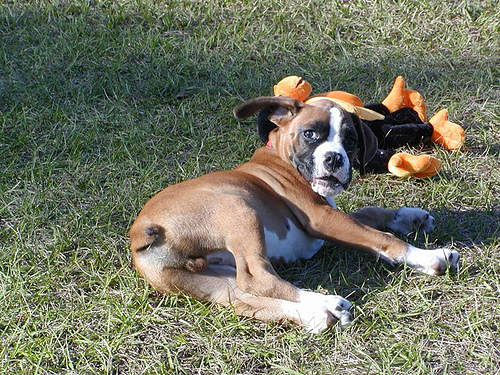This video is courtesy of Animal Planet.
Boxer Dog Breed Info
Dog Breed Group: AKC Working, Mastiff
Height: Males 22-25 inches, Females 21-24 inches
Weight: Males 60-70 lbs, Females 55-65 lbs
Life Expectancy: 10-14 years
Energy: High
Grooming: Minimal
Ease of Training: Fairly Easy
The Boxer is an absolute favorite breed to many dog enthusiasts. They have a very loyal following of owners and for good reason. They formed as a result of the Bullenbeiser and Bulldog in late 19th century Germany, becoming officially recognized in the early 1900’s.
They were originally bred to be medium-sized guard dogs, used for hunting deer, bears, and boars, and were even known to be circus dogs. After the first World War, they were introduced into the United States and immediately became popular family pets.
Boxers are known for being very friendly, intelligent, protective, and gentle. They have high energy and need lots of love and attention.
Appearance
Boxers are medium to large-sized dogs with short, square muzzles. They have short hair, which can shed, no matter what you’ve been told. Boxers are very muscular, with broad chests and square heads that can give an aggressive appearance. Although they may look imposing, they are indeed very gentle.
They are fawn or brindle in color, with flash (white) in varying degrees. Brindle is basically fawn with black stripes. About 20% of all boxers are dominantly white in appearance, due to a lack of pigment. Some boxers can give the appearance of being black due to the overwhelming presence of brindle, which can be referred to as ‘reverse-brindle’.
Temperament
Boxers are generally very gentle dogs, with unbelievable patience. They are fantastic with small children and the elderly, although they do require a high amount of exercise. With proper walks and play-time, boxers can even get accustomed to living in small homes and apartments.
They show very little signs of aggression with people or other pets, but this of course varies based on the environment the dog grows up in. They do have a natural instinct to treat small critters as prey, due to their genetic background as hunting dogs. Squirrels, rabbits and birds can especially trigger this. In most cases, though, boxers can befriend any small animal as long as they are in the proper environment.
Boxers are generally easy to train, being a dog who loves to please their owners. Housebreaking them is usually quite painless compared to other breeds. They respond well to commands and are fast learners. They are extremely smart and intuitive, learning many things by observing human interactions. So, watch what you say, because your boxer is listening.
Maintenance
Being short-haired dogs, boxers require very minimal grooming. Run a brush through them once a week or so to remove dead hair. Their nails do require regular clipping, though. Of course, boxers require all of the standard shots and vet office visits, just as any other dog.
Exercise is the most important aspect of maintaining your boxer’s well-being. Boxer dogs require daily exercise due to their high energy, as well as adequate play time. They are extremely playful by nature and usually do not grow out of puppyhood until at least three years old. Although, some boxers have been known to remain playful well into their seniority.
Health
Each and every dog breed is prone to certain specific health conditions, so do not let something like this scare you away from a particular breed.
Boxers have a general lifespan of 10-14 years and are generally healthy dogs. They are, however, known for developing a few health issues:
Cancer: brain tumors, mast tumors, and skin cancer in white boxers.
Hip Dysplasia
Cardiac Issues: Aortic Stenosis, Sub-Aortic Stenosis
Thyroid Problems: Hypothyroidism
Arthritis
Allergies
Deafness: mostly in white boxers





